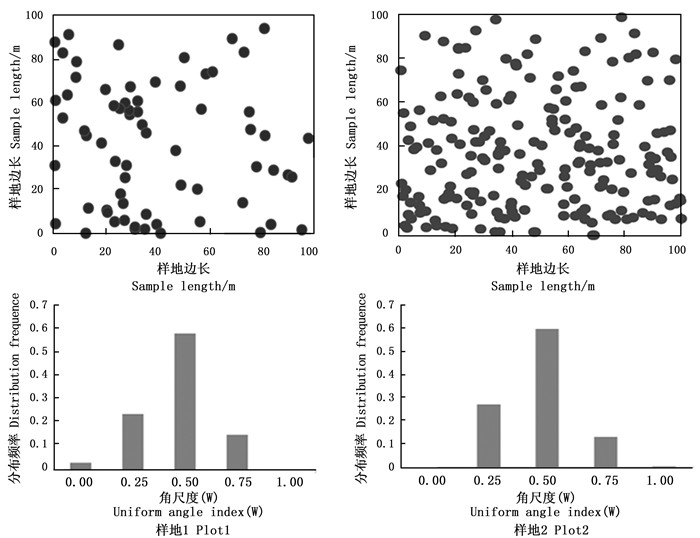-
林木个体的生长发育和死亡是森林生态系统动态过程的重要特征,它不仅取决于林木自身的遗传特性,而且取决于生境质量及林木对环境资源的利用能力[1-2]。枯立木广泛存在于森林生态系统中,是森林生态系统的重要组成部分之一,它们在森林生态系统中发挥着许多重要的、独特的生态功能,参与能量流动和养分循环, 影响土壤和沉积物质的运输和储存,是许多物种的栖息地和生存基质[3-7]。在早期的森林生态学研究中,一般都以活立木为研究对象,枯立木并不被学者和管理人员所重视,直至20世纪中后期,美欧等国家开始了森林粗木质残体(Coarse Woody Debris,CWD)相关研究,枯死木和枯立木对整个生态系统起到巨大贡献才逐步被人们所认识[8-9]。20世纪80年代起,为森林生态系统结构和功能研究提供基础性数据支持,为森林资源保护、经营提供借鉴和参考[10-17],国内学者相继针对不同地区的各种森林类型中的枯死木、枯立木的数量特征、分布格局、结构和功能等开展了研究,但对枯立木的微环境研究重视不够。
樟子松(Pinus sylvestris var. mongolica Litv.) 是欧洲赤松(P.sylvestris Carr.) 的一个地理变种,在我国主要集中分布在呼伦贝尔高原东部、海拉尔河中游及支流伊敏河、辉河流域和哈拉哈河上游一带的固定沙丘上。沙地樟子松为第三纪孑遗植物,是研究物种起源、进化、演替和新物种培育重要的基因资源[18-19];此外,樟子松具有喜光、耐旱、抗寒、耐土壤瘠薄等特点,在生态治理以及环境保护中的防风固沙作用显著,因此,在以往的研究中就樟子松林的植物属的分布区类型、种子植物区系、遗传多样性、群落结构、天然更新、生长状况及结实规律以及林火的影响、引种适应性及发展潜力等方面开展了大量的研究工作[20-25],然而对于樟子松天然林枯立木的特征鲜有报道,本文利用天然樟子松纯林每木定位样地,研究樟子松林中枯立木的数量及空间结构特征,以期探讨枯立木的成因,为保护和经营樟子松林提供借鉴。
HTML
-
研究地位于内蒙古呼仑贝尔红花尔基自然保护区内。红花尔基是樟子松天然林分布最具有代表性的地段,林带长约150 km、宽10~20 km,地理位置为47°36′~48°35′N, 118°58′~ 120°32′E。该地区属半湿润半干旱气候, 年均降水量344 mm, 主要集中在7月至8月;年均蒸发量1 174 mm;年平均气温-1.5℃,大于10℃的年积温达2 000℃;平均无霜期90 d左右。区内以垄状和波状起伏沙地地貌类型为主, 海拔700~1 100 m。红花尔基樟子松林多为纯林, 在阴坡凹地混生有山杨(Populus davidiana Dode.)、白桦(Betula platyphylla Suk.) 及山荆子(Malus baccata L.)等伴生树种, 形成混交林。
2015年8月,在红花尔基自然保护区诺干诺尔林场的樟子松纯林中较为平缓的地段运用全站仪设立了2个面积为100 m×100 m的每木定位固定样地,样地海拔815 m,坡度小于3度。据当地林业部门记载,2块样地所在的林班仅在1985年以前采用渐伐的方式进行过木材生产,保留部分母树,进行天然更新,此后30年多年没有进行过任何经营活动。
-
对样地内所有胸径大于5 cm的立木,包括活立木和枯立(倒)木运用全站仪进行定位,对样地进行全面调查,调查内容包括坡度、海拔、郁闭度、树高、树种、胸径、更新等。树高采用布鲁莱斯测高器进行测量;样地位置(地理坐标、海拔)采用GPS确定;在样地4个角和中心分别设置10 m×10 m的样方,再把10 m×10 m的样方划成4个5 m×5 m的小样方,调查灌木、草本及更新幼苗或幼树。
-
样地中活立木和枯立木的水平分布格局运用森林空间结构分析软件Winkelmass进行分析,在分析不同立木的分布格局时需要单独进行分析,如分析枯立木的水平格局时,需要将活立木的坐标去除,并运用角尺度判断林木分布格局检验方法判断林木分布格局[26]。在分析枯立木微环境特征时采用李远发等[27]提出的林分空间结构二元分布方法,将枯立木和活立木坐标放在一起用空间结构参数来进行分析,此时,将枯立木周围最近4株邻体中活立木所占的比例定义为活立木比,用来表达枯立木周围活立木的分布数量。Winkelmass在计算空间结构参数时为避免边缘效应对林分结构的影响,本研究设置了5 m缓冲区,核心区面积为90 m×90 m。
2.1. 样地调查
2.2. 数据分析
-
对2块沙地樟子松样地进行全面调查发现,样地内所有胸径大于5 cm的林木均为樟子松,在更新调查中几乎没有发现其它树种,灌木也非常罕见;样地基本特征如表 1所示,样地中活立木的径级分布如图 1所示。图 1表明,样地1活立木的径级结构呈多峰山状曲线,而样地2的径级结构则呈左偏单峰结构,2块样地的径级分布类似于同龄林;按照樟子松林龄级与龄组的划分标准,2块样地的林分应该为幼中林。表 1表明,2块样地中的更新幼苗高度绝大部分为小于10 cm的幼苗,其中,样地1中的幼苗仅有2 960株·hm-2,草本层的盖度较大,达到了80%以上;而样地2林下更新的幼苗则达到15 280株·hm-2,草本盖度则小于50%,但需要指出的是调查过程中几乎看不到幼树。产生这种现象的原因可能有2种情况,一方面可能是由于在过去取材时保留母树的数量不同,导致土壤种子库中种子数量的差异,进而导致更新幼苗较少;另一方面可能与林分密度以及草本盖度有直接关系,由于样地2密度较大,林内光照不足,导致草本植物难以生长,樟子松幼苗得以更新,但由于林分密度过大,幼苗很难成为幼树;对于样地1而言,由于密度低,草本植物大量生长,与樟子松幼苗竞争激烈,导致更新无法完成。曾德慧等[28]研究认为,樟子松幼苗更新与草本的盖度存在着一定的相关性,适宜的草本盖度对樟子松更新有促进作用,当盖度大于80%则对樟子松幼苗的更新起到阻碍作用,本研究的调查结果也印证了这一推论。
样地代码
Plot code坡度
Slope/(°)海拔
Average elevation/m郁闭度
Canopy density平均胸径
Average diameter/cm平均树高
Average height/m断面积
Basal area/(m2·hm-2)密度
Density/(株·hm-2)蓄积
Stock volume/(m3·hm-2)更新幼苗
Regeneration seedling/(株·hm-2)草本盖度
Herbaceous coverage/%1 <3 815 0.7 21.3 14.8 33.6 940 209.1 2 960 >80 2 <3 815 0.7 21.0 16.3 39.8 1 149 273.8 15 280 <50 Table 1. The plot characteristics of Pinus sylvestris var. mongolica natural pure forest
-
2块样地中几乎没有倒木,样地1中共有枯立木67株,平均胸径为7.8 cm,平均高为8.4 m,枯立木树干上并没有发现明显的虫害痕迹;样地2内有枯立木200株,平均胸径为9.4 cm,平均高为7.5 m,其中,有32株枯立木树干上发现了明显的虫害痕迹,占全部枯立木的16%。对2块样地枯立木径级结构进行统计分析,如图 2所示。由图 2可以看出,样地1中枯立木胸径主要分布在5~7 cm之间,占全部枯立木的55.2%,7~9 cm和9~11 cm的枯立木比例相差不大,分别占全部枯立木的17.9%和16.4%,大于11 cm的枯立木仅占10.4%,说明样地中绝大数枯立木胸径小于11 cm。样地2中枯立木径级分布幅度较样地1宽,最大胸径达到26 cm,其中,胸径在5~7 cm和7~9 cm的枯立木比例分别为34.5%和29.5%,二者合计占全部枯立木的64%,胸径在9~11 cm的枯立木为15.5%,其他径阶的枯立的比例均小于10%,随着径阶的增大,枯立木株数减少。值得注意的是,在样地1中,枯立木径阶分布没有出现间断的现象,而在样地2中,没有胸径在20~22 cm间的枯立木,而大于23 cm的枯立木也仅有2株。
-
运用空间结构分析软件Winkelmass对2块样地的立木的分布格局进行分析,包括活立木和枯立木。样地1所有立木的平均角尺度为0.470,样地2所有立木的平均角尺度也为0.470。运用Zhao zhonghua等[26]提出的角尺度判断林木分布格局检验方法对这2块样地的格局进行判断,2块样地都为均匀分布向随机分布过渡类型。对样地中的枯立木的分布格局进行分析,图 3为2块样地中枯立木的分布图及角尺度分布频率。在样地1中,枯立木之间的最小平均距离为6.17 m,最大平均距离为13.65 m,枯立木组成的结构单元有60%的角尺度值为0.5,有13%的为0.25,角尺度为0.75和1的分别为18%和9%,样地中没有角尺度为0的结构单元,枯立木的平均角尺度为0.539,其分布格局为随机分布。在样地2中,枯立木之间的最小平均距离为3.38 m,最大平均距离为7.42 m,枯立木组成的结构单元角尺度值为0.5的占55%,为0.25的占21%,为0.75和1的分别占17%和7%,该样地中也没有角尺度为0的结构单元,枯立木的平均角尺度为0.508,其分布格局也为随机分布。由以上分析可以看出,2块样地中枯立木的分布格局与整个林分的分布格局不同,林分中枯立木的死亡表现出一定的随机性。
-
将2块样地所有立木作为研究对象,分析以枯立木为参照树与其最相邻4株立木组成的结构单元的特征。表 2为2块样地中所有枯立木的空间结构参数的分布特征。由表 2可以看出:在2块样地中,枯立木最近4株相邻立木大多随机分布在枯立木周围,完全均匀或聚集的比例极少;在样地1中,76.1%的结构单元中枯立木周围的4株相邻立木的胸径较其大,20.9%的结构单元枯立木周围有3株较其胸径大,仅有3%的枯立木周边分布有2株较其小的立木,样地中没有枯立木比3株或4株相邻木都大的结构单元。与样地1不同,在样地2中,有64.5%的枯立木周边4株最近相邻木的胸径较其大,有1株和2株相邻立木较枯立木小的结构单元所占比例分别为27.5%和6%,有3株相邻木较枯立木小的结构单元的比例为2%;从2块样地的活立木比可以看出,在样地1中,有80.6%的枯立木周围分布的是活立木,19.4%的枯立木与1株枯立木相邻,样地中没有2株以上枯立木相邻的情况。在样地2中,有52.5%的枯立木周围分布的是活立木,有38%的枯立木与1株枯立木相邻,分别有7.5%和2.0%的枯立木周围分布有2株和3株枯立木。以上分析表明,在样地1中枯立木很少连续分布,而样地2中,枯立木连续分布的现象比较普遍。
参数取值Parameter value 样地1 plot 1 样地2 plot 2 0 0.25 0.5 0.75 1 0 0.25 0.5 0.75 1 角尺度Uniform angle index 0.030 0.239 0.582 0.149 0.000 0.000 0.270 0.595 0.130 0.005 大小比数Dominance 0.000 0.000 0.030 0.209 0.761 0.000 0.020 0.060 0.275 0.645 活立木比Living tree ratio 0.000 0.000 0.000 0.194 0.806 0.000 0.020 0.075 0.380 0.525 Table 2. Distribution characteristics of structural parameters of the dead standing trees in Pinus sylvestris var. mongolica natural pure forest
-
为进一步解析2块样地中枯立木空间结构特征,对2块样地枯立木结构参数进行两两联合,分析枯立木空间结构参数的二元分布特征,如图 4所示。由图 4可以看出:在样地1中,角尺度-大小比数的25种组合关系中,出现了9种组合,大小比数为1和角尺度为0.5组合的频率最高,占所有枯立的41.8%,即有41.8%的枯立木周围最近4株相邻立木较其大且随机分布在其周围;其次为大小比数为1,角尺度值为0.25的组合,占所有枯立木的19.4%,处于第三位的是大小比数为0.75,角尺度值为0.5的组合,占所有枯立木的14.9%;处于第4位是大小比数为1,角尺度为0.75的组合,占枯立木的11.9%;还有5种组合关系所占比例都较小,总计占枯立木的11.9%。角尺度-活立木比二元分布的25种组合关系,仅出现了6种,其中,角尺度为0.5,活立木比为1的组合占44.8%,其次为角尺度为0.25,活立木比为1的组合,其比例为17.9%,处于第三位的是角尺度值为0.75,活立木比为1的组合,其比例为14.9%,处于第4位的是角尺度为0.5,活立木比为0.75的组合,其比例为13.4;还有2种组合分别为角尺度为0.25,活立木比为0.75及角尺度为0,活立木比为1的组合,其比例分别为6%和3%,样地中再没有其他组合。样地1大小比数-活立木比仅出现5种组合关系,其中,大小比数为1,活立木比为1,0.75和0.25的组合的比例分别为67%、10%和3%,大小比数为0.75,活立木比为1和0.75组合的比例分别为9%和10%。从以上分析可以看出,在样地1中,以枯立木为参照树的结构参数二元分布组合关系相对单一,绝大多数枯立木都较其相邻木小,这些相邻木大多为活立木且随机地分布在枯立木周围。
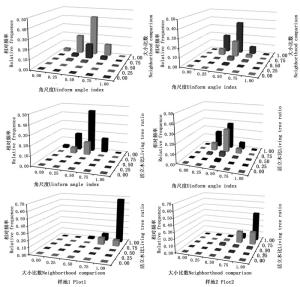
Figure 4. Distribution characteristics of spatial structure parameter two element distribution of the dead standing trees in Pinus sylvestris var. mongolica natural pure forest
在样地2中,角尺度-大小比数的25种组合关系,出现了12种,其中,角尺度为0.5,大小比数为0,0.25,0.5,0.75和1的这5种组合的比例分别为0%,1.5%,4.0%,17.5%和36.5%;角尺度为0.25,大小比数仅出现0.5,0.75和1这3种组合,其比例分别为0.5%,7.0%和19.5%;角尺度为0.75,大小比数为0.25,0.5,0.75和1这4种组合,其比例分别为0.5%,1.5%,3.0%和8.0%;角尺度为1,大小比数也为1的组合比例为0.5%。角尺度-活立木比25种组合关系,出现了11种,角尺度为0.5,随着活立木比的增加(0.00→1.00),其组合比例分别是0%,2.0%,4.5%,25.0%和28.0%;角尺度为0.25,仅出现活立木比为0.5,0.75和1这3种组合,其比例分别为2.0%,8.0%和17.0%;角尺度为0.75,与活立木比组合也为3种类型,即活立木比为0.5,0.75和1,其比例分别是1.0%,5.0%和7.0%。角尺度为1,活立木比也为1的比例仅为0.5%。大小比数-活立木比25种组合关系,出现了12种,其中,当活立木比为1时,出现4种组合,即大小比数为0.25,0.5,0.75和1,其比例分别为1.0%,2.0%,19.0%和43.5;随着活立木比的减小,出现的组合增加。当活立木比为0.75时,出现4种组合,即大小比数为0.25,0.5,0.75和1,其比例分别为1.0%,2.0%,17.5%和7.0%;当活立木比为0.5时,出现4种组合,即大小比数为0.25,0.5,0.75和1,其比例分别为0.5%,3.0%,1.5%和1.0%;
从2块样地的枯立木结构参数一元分布和二元分布特征分析可以看出,运用一元分布特征能够解析样地中枯立木与其周围4株相邻木的总体特征和差异,对于2块样地来说,也能从一元分布中看到一些差异,但其不能明确提供每棵枯立木与周围最近4株相邻木的关系;运用结构参数二元分布能够更加详尽的刻画每株枯立木与其相邻木的关系。从图 4可以看出:2块样地中,二元分布更加明确地反映出了林分中枯立木与最近相邻木的关系,样地2枯立木结构参数二元分布组合较样地1复杂,其中,角尺度-大小比数二元分布特征2块样地相差不大,但角尺度-活立木比二元分布特征和大小比数-活立木比二元分布特征2块样地表现出明显的差异:样地1中,枯立木的最近4株随机分布于其周围的相邻木为活立木且胸径大于枯立木的比例明显高于样地2,而样地2中,枯立木最近4株随机分布于其周围的相邻木有枯立木的比例明显高于样地1,这进一步说明了样地2中枯立木有连续死亡的情况。
3.1. 樟子松天然林的基本特征
3.2. 沙地樟子松天然林枯立木数量特征
3.3. 樟子松天然林枯立木空间结构特征
3.3.1. 枯立木分布格局
3.3.2. 樟子松天然林枯立木最近相邻木特征
3.3.3. 樟子松天然林枯立木二元分布特征
-
枯立木是森林生态系统物质循环不可或缺的重要组成部分,为林分更新提供场所,在保持生态系统的完整性方面扮演着重要角色。沙地樟子松天然纯林是一个比较独特的森林生态系统,在红花尔基诺干诺尔林场建立的2块樟子松天然纯林样地相距不远,样地立地条件基本相同,但样地内的活立木和枯立木特征不尽相同。从2块样地的活立木径级分布特征来看,既不像典型人工林直径分布,也与典型天然林倒“J”型径阶结构不同,分析原因可能为此林分正处于演替更新的早期阶段,发育尚未完全[29]。从2块样地的枯立木的数量特征上来看,样地1中枯立木数量较少,样地2中较大,且都以小径级林木为主,胸径集中在11 cm以下;从空间分布来看,2块样地中的枯立木均为随机分布,与林木整体的分布格局不同,说明样地中枯立木的形成是随机的;2块样地中的枯立木所处的微环境差异明显,样地1中的枯立木周围的4株相邻立木大多为活立木,且胸径较枯立木大;样地2中,只有一半的枯立木周围的相邻4株立木为活立木,且有三分之一以上的枯立木胸径不是最小的,枯立木有连续分布的现象。
植物个体间的竞争主要是对水、气、光、热及营养元素的竞争,是影响植物生长、形态和存活的主要因素之一。班勇等[11]对兴安落叶松(Larix gmelinii (Rupr.) Kuzen.)老龄林的枯立木研究认为,枯立木的形成主要有3个原因,即火烧、被压导致生长衰退直至死亡和寿命终极3个方面,出现倒木是老龄林的特征之一。对于本研究的2块样地而言,近50年没有遭受火烧,样地中几乎看不到倒木,因此,林木也没有达到寿命终极阶段,因而造成林分中出现枯立木的主要原因是林木间的竞争激烈,小径木被压而导致死亡。对于样地1而言,密度较小,林木个体间的平均距离较大,生长空间相对较大,林木间对资源的竞争相对较弱,因而林内的死亡林木数量较少,也很少出现枯立木连续分布的现象;而样地2的林分密度相对较大,林木的生长空间较小,因而出现了枯立木连续分布的现象。
-
樟子松天然林在其主要分布区生态治理以及防风固沙方面扮演着重要的角色,国家也把樟子松列为二级珍贵保护树种,对樟子松林进行了严格的保护,特别是天然林保护工程实施以来,对于樟子松林的经营管理日趋严格。本研究分析了樟子松天然林中枯立木的特征,为分析枯立木的微环境特征和成因,提出了活立木比的概念。从2块樟子松天然纯林的林分特征和枯立木特征来看,樟子松林密度过大会导致林木竞争非常的激烈,容易出现大量的枯立木。因此,樟子松纯林要进行适度的经营。对于样地1所代表的林分类型来说,首先伐除林分中所有不健康林木和枯立木,选择生长健壮的林木作为培育对象,并伐除影响其生长的最近相邻木,保证其至少2面受光,保持合理的密度,此外,还需要对林下草本植物采取除草破土的措施,增加林下更新。对于样地2代表的林分类型而言,首先要大幅度降低林分密度,将林分中的枯立木伐除,特别是要将已发现了明显的虫害痕迹的枯立木进行清理,降低病虫害及森林火险等级;然后,选择生长健壮的林木作为培育对象,运用结构化经营方法中的大小比数、密集指数等指数来指导结构优化,降低培育对象的竞争压力,增加生长空间,适当增加林内天窗,促进林下更新,最终实现培育健康稳定森林的目的。

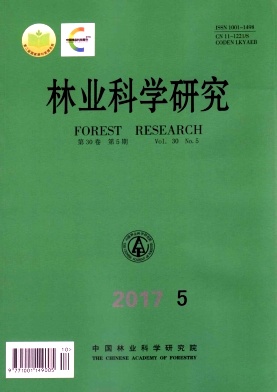


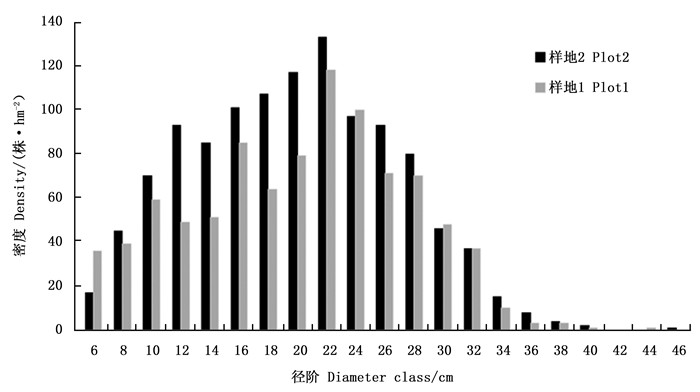

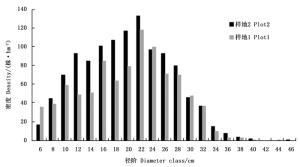

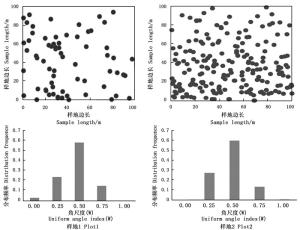
 DownLoad:
DownLoad:

